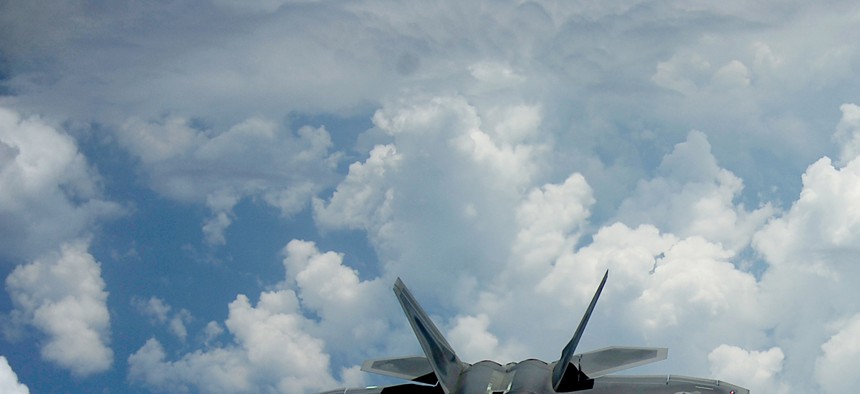
Two of the U.S. Air Force's F-22 Raptors in flight. U.S. Air Force photo by Master Sgt. Jeremy Lock
F-22 Finally Makes Its Combat Debut Against Syria
Seven years after they were declared battle ready, the $370 million jet sees action. By Marcus Weisgerber
The U.S. Air Force used the stealthy F-22 Raptor to bomb Islamic State militant targets in Syria, marking the first time the expensive jet has been used in combat.
A senior military official confirmed to Defense One the Pentagon’s use of the stealthy jet in the air strikes, which is significant considering it was declared battle-ready in 2005.
The U.S. military has regularly deployed Lockheed Martin-built F-22s to al-Dhafra Air Base, a sprawling military complex just south of Abu Dhabi, since at least 2012. However the Pentagon does not acknowledge the jets are based there due to sensitivities expressed by the United Arab Emirates government.
The jets were originally sent to the Middle East base to deter Iran from building nuclear weapons. But the radar-evading machines are tailor made for missions they conducted Monday night and early Tuesday morning in Syria, which has sophisticated surface-to-air missiles that could detect and shoot down aircraft, said Mark Gunzinger, a retired Air Force colonel now with the Center for Strategic and Budgetary Assessments in Washington.
“That’s not unexpected considering DOD is now conducting missions into Syria,” Gunzinger said of the F-22's participation.
Center for Strategic and Budgetary Assessments
This week’s airstrikes in Syria are the latest example of the U.S. military using technologies developed in the 1980s, originally conceived for battle with the Soviet Union, Gunzinger said.
“The combination of aircraft in particular with stealth, speed, multi-mission capability and precision strike capabilities have proven themselves time and again,” he said. “This is just another conflict where the combination of those capabilities has undoubtedly proven very effective.”
The U.S. military has paid nearly $70 billion to develop and buy 187 F-22s. When factoring in development and production costs, each aircraft has a price tag of about $370 million. The jets are now undergoing a major multibillion-dollar upgrade to improve intelligence gathering and air-to-ground attack capabilities.
Originally conceived as a purely air-to-air combat aircraft, much like the Boeing F-15 Eagle, the F-22 was designed to best high-end Russian fighters in aerial dogfights. But in the early 1990s, a decision was made to give the twin-engine jet a bomb-dropping capability, Gunzinger said.
“The initial decision was to modify about half of them; and then later on it was to modify all of them,” Gunzinger said.
That meant installing an internal weapons bay in the belly of each jet. Other Air Force, Navy and Marine Corps fighters in the Defense Department arsenal carry weapons on their wings, making them more detectable on radar. Storing the weapons inside the plane combined with an advanced radar and special coating on of the skin of the aircraft reduce the chances of being seen.
The Air Force originally envisioned a fleet of more than 700 F-22s. That number progressively fell to 381 and the current fleet of 187.




